Publication Lists
・Original Papers(2025 / 2024 / 2023 / 2022 / 2021 / 2020 / 2019 / 2018 / 2017 / 2016 / 2015 / 2014 / 2013 / 2012 / 2011 / 2010 / 2009 / 2008 / 2007 / 2006 / 2005 / 2004 / 2003 / 2002)
・Review&Books
2014

●Conversion from Pillar[5]arene to Pillar[6-15]arenes by Ring Expansion and Encapsulation of C60by Pillar[n]arenes with Nanosize Cavities
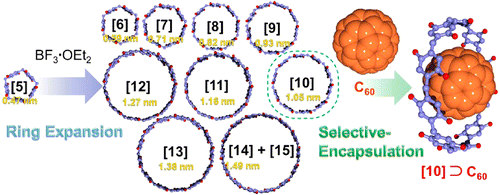
Conversion of ring size from pillar[5]arene to pillar[6–15]arenes and isolation of pillar[n]arene homologues (n = 11–13) with known pillar[n]arene homologues (n = 6–10) are demonstrated. Pillar[10]arene formed the most stable host–guest complex with C60 among the pillar[5–14]arenes.
Ogoshi, Tomoki; Ueshima, Naosuke; Sakakibara, Fumiyasu; Yamagishi, Tada-aki; Haino, Takeharu, Org. Lett., 2014, 16, 2896-2899
●Supramolecular Fullerene Polymers and Networks Directed by Molecular Recognition between Calix[5]arene and C60
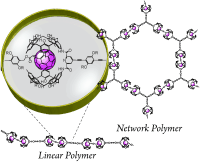
A biscalix[5]arene–C60 supramolecular structure was utilized for the development of supramolecular fullerene polymers. Di‐ and tritopic hosts were developed to generate the linear and network supramolecular polymers through the complexation of a dumbbell‐shaped fullerene. The molecular association between the hosts and the fullerene were carefully studied by using 1H NMR, UV/Vis absorption, and fluorescence spectroscopy. The formation of the supramolecular fullerene polymers and networks was confirmed by diffusion‐ordered 1H NMR spectroscopy (DOSY) and solution viscometry. Upon concentrating the mixtures of di‐ or tritopic hosts and dumbbell‐shaped fullerene in the range of 1.0–10 mmol L−1, the diffusion coefficients of the complexes decreased, and the solution viscosities increased, suggesting that large polymeric assemblies were formed in solution. Scanning electron microscopy (SEM) was used to image the supramolecular fullerene polymers and networks. Atomic force microscopy (AFM) provided insight into the morphology of the supramolecular polymers. A mixture of the homoditopic host and the fullerene resulted in fibers with a height of (1.4±0.1) nm and a width of (5.0±0.8) nm. Interdigitation of the alkyl side chains provided secondary interchain interactions that facilitated supramolecular organization. The homotritopic host generated the supramolecular networks with the dumbbell‐shaped fullerene. Honeycomb sheet‐like structures with many voids were found. The growth of the supramolecular polymers is evidently governed by the shape, dimension, and directionality of the monomers.
Hirao, Takehiro; Tosaka, Masatoshi; Yamago, Shigeru; Haino, Takeharu, Chem. Eur. J., 2014, 20, 16138-16146
●Guest Induced Head-to-tail Columner Assembly of 5,17-Difunctionalized Calix[4]arene
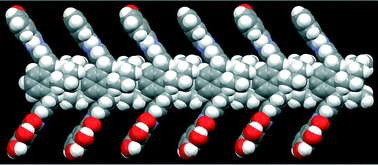
Calix[4]arene possessing two catechol side arms 1 and organic molecules (nPrOH, AcOH, AcOEt, and CH3CN) crystallized to afford cocrystals: 1·(nPrOH)4, 1·(AcOH)4, 1·(AcOEt), and 1·(CH3CN)2. In these cocrystals, calix[4]arene 1 is arranged one-dimensionally, forming head-to-tail columnar structures. The organic guests settle in the residual space between the columnar structures; they are captured by the catechol side arms through hydrogen bonding. In the cocrystal 1·(H2O)2, a continuous zigzag array of 1 is formed instead of the columnar assembly, demonstrating that the organic guests induced the formation of the head-to-tail columnar structures in the crystal packing. The crystalline apohost 1apo was prepared by the desorption of the MeOH guests from the cocrystal 1·(MeOH)4; this compound adsorbed the MeOH vapour, reconstructing the original crystal packing. When 1apo adsorbed the iPrOH vapour, a cocrystal with a crystal structure similar to that of 1·(MeOH)4 was formed, suggesting that 1apo has a crystal structure similar to that of 1·(MeOH)4.
Sekiya, Ryo; Yamasaki, Yutaro; Tada, Wataru; Shio, Hidemi; Haino, Takeharu, CrystEngComm, 2014, 16, 6023-6032
●High Diastereoselection of Dissymmetric Capsule by Chiral Guest Complexation

Encapsulation of chiral guests in the dissymmetric capsule 1⋅4 BF4 formed diastereomeric supramolecular complexes G⊂1⋅4 BF4 (G: guest). When chiral guests 2 a–q were encapsulated within the dissymmetric space of the self‐assembled capsule 1⋅4 BF4, circular dichroism (CD) was observed at the absorption bands that are characteristic of the π–π* transition of the bipyridine moiety of the capsule, which suggests that the P and M helicities of the capsule are biased by the chiral guest complexation. The P helicity of diastereomeric complex (S)‐2 l⊂1⋅4 BF4 was determined to be predominant, based on CD exciton coupling theory and DFT calculations. The diastereoselectivity was highly influenced by the ester substituents, such that benzyl ester moieties were good for improving the diastereoselectivity. A diastereomeric excess of 98 % was achieved upon the complexation of 2 j. The relative enthalpic and entropic components for the distereoselectivity were obtained from a van’t Hoff plot. The enthalpic components were linearly correlated with the substituent Hammett parameters (σp+). The electron‐rich benzyl ester moieties generated donor–acceptor π–π stacking interactions with the bipyridine moiety, which resulted in a significant difference in energy between the predominant and subordinate diastereomeric complexes.
Tsunoda, Yuta; Fukuta, Katsunori; Imamura, Taisuke; Sekiya, Ryo; Furuyama, Taniyuki; Kobayashi, Nagao; Haino, Takeharu, Angew. Chem. Int. Ed., 2014, 53, 7243-7247
●White-Light-Emitting Edge-Functionalized Graphene Quantum Dots
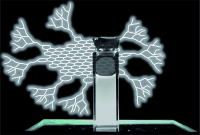
Graphene quantum dots (GQDs) have received considerable attention for their potential applications in the development of novel optoelectronic materials. In the generation of optoelectronic devices, the development of GQDs that are regulated in terms of their size and dimensions and are unoxidized at the sp2 surfaces is desired. GQDs functionalized with bulky Fréchet’s dendritic wedges at the GQD periphery were synthesized. The single‐layered, size‐regulated structures of the dendronized GQDs were revealed by atomic force microscopy. The edge‐functionalization of the GQDs led to white‐light emission, which is an uncommon feature.
Sekiya, Ryo; Uemura, Yuichiro; Murakami, Hideki; Haino, Takeharu, Angew. Chem. Int. Ed., 2014, 53, 5619-5623
●Development of Ultraviolet-Ultraviolet Hole-burning Spectroscopy for Cold Gas Phase Ions
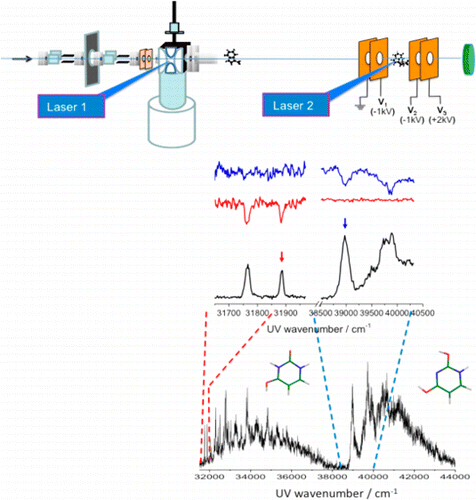
A new ultraviolet–ultraviolet hole-burning (UV–UV HB) spectroscopic scheme has been developed for cold gas-phase ions in a quadrupole ion trap (QIT) connected with a time-of-flight (TOF) mass spectrometer. In this method, a pump UV laser generates a population hole for the ions trapped in the cold QIT, and a second UV laser (probe) monitors the population hole for the ions extracted to the field-free region of the TOF mass spectrometer. Here, the neutral fragments generated by the UV dissociation of the ions with the second laser are detected. This UV–UV HB spectroscopy was applied to protonated dibenzylamine and to protonated uracil. Protonated uracil exhibits two strong electronic transitions; one has a band origin at 31760 cm–1 and the other at 39000 cm–1. From the UV–UV HB measurement and quantum chemical calculations, the lower-energy transition is assigned to the enol–keto tautomer and the higher-energy one to the enol–enol tautomer.
Féraud, Géraldine; Dedonder-Lardeux, Claude; Jouvet, Christophe; Inokuchi, Yoshiya; Haino, Takeharu; Sekiya, Ryo; Ebata, Takayuki, J. Phys. Chem. Lett., 2014, 5, 1236-1240
●Formation of Host-Guest Complexes on Gold Surface Investigated by Surface-Enhanced IR Absorption Spectroscopy
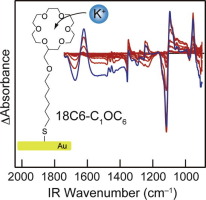
We apply surface-enhanced infrared absorption (SEIRA) spectroscopy to host–guest complexes in liquid phase to examine the structural change in the complex formation. Two thiol derivatives of 18-crown-6 (18C6) are chemisorbed on a gold surface, and aqueous solutions of MCl salts (M = Li, Na, K, Rb, and Cs) are put to form M+·18C6 complexes. Infrared spectra of these complexes in the 900–2000 cm−1 region are obtained by SEIRA spectroscopy. The observed IR spectra show noticeable peaks due to the complex formation, demonstrating that SEIRA spectroscopy will be a powerful method to investigate the structure of host–guest complexes in supramolecular chemistry.
Inokuchi, Yoshiya; Mizuuchi, Takahiro; Ebata, Takayuki; Ikeda, Toshiaki; Haino, Takeharu; Kimura, Tetsunari; Guo, Hao; Furutani, Yuji, Chem. Phys. Lett., 2014, 592, 90-95
DOI:10.1016/j.cplett.2013.12.026
●Self-Assembly of Oligo(phenylisoxazolyl)benzenes Induced by Multiple Dipole-Dipole Interactions
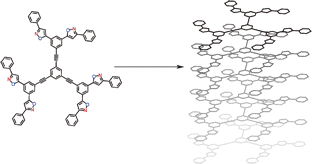
We have demonstrated that oligo(phenylisoxazolyl)benzenes 3–6 formed polymeric assemblies. The intermolecular associations were discussed using thermodynamic parameters. The formation of the polymeric assemblies were confirmed by DOSY and AFM measurements. The large polymeric structures were observed both in solution and in the solid state. The multiple dipole–dipole interactions were crucial for the supramolecular polymerization of the oligo(phenylisoxazolyl)benzenes.
Haino, Takeharu; Ueda, Yuko; Hirao, Takehiro; Ikeda, Toshiaki; Tanaka, Masahiro, Chem. Lett., 2014, 43, 414-416
●Ion-based Assemblies of Planer Anion Complexes and Cationic PtII Complexes
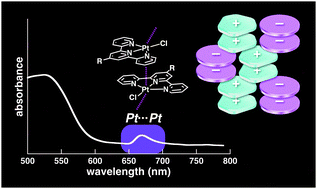
Because the metallophilicity of attractive PtII⋯PtII interactions helps in the fabrication of columnar structures, terpyridine–PtII complexes were used as planar counter cationic species for formation of charge-segregated assemblies using π-conjugated receptor–Cl− complexes as planar anions.
Sekiya, Ryo; TsuTsui, Yusuke; Choi, Wookjin; Sakurai, Tsuneaki; Seki, Shu; Bando, Yuya; Maeda, Hiromitsu, Chem. Commun., 2014, 50, 10615-10618
●Synthesis, Characterization, X-ray Crystal Structurte, DFT Calculations and Catalytic Properties of a Dioxovanadium(V) Complex Derived from Oxamohydrazide and Pyridoxal - A model Complex of Vanadate Dependent Bromoperoxidase)
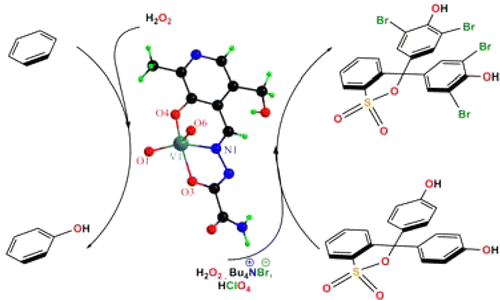
A vanadium(V) complex with the formula [Et3NH][VVO2(sox-pydx)] with a new tridentate ligand 2-[2-[[3-hydroxy-5-(hydroxymethyl)-2-methylpyridin-4-yl]methylene]hydrazinyl]-2-oxoacetamide (soxH-pydxH), obtained by condensation of oxamohydrazide and pyridoxal (one of the forms of vitamin B6), has been synthesized. The compound was characterized by various analytical and spectroscopic methods, and its structure was determined by single-crystal X-ray diffraction technique. Density functional theory (DFT) and time-dependent DFT calculations were used to understand the electronic structure of the complex and nature of the electronic transitions observed in UV–vis spectra. In the complex, vanadium(V) is found to be pentacoordinated with two oxido ligands and a bianionic tridentate ONO-donor ligand. The vanadium center has square-pyramidal geometry with an axial oxido ligand, and the equatorial positions are occupied by another oxido ligand and a phenolato oxygen, an imine nitrogen, and a deprotonated amide oxygen of the hydrazone ligand. A DFT-optimized structure of the complex shows very similar metrical parameters as determined by X-ray crystallography. The O4N coordination environment of vanadium and the hydrogen-bonding abilities of the pendant amide moiety have a strong resemblance with the vanadium center in bromoperoxidase enzyme. Bromination experiments using H2O2 as the oxidizing agent, with model substrate phenol red, and the vanadium complex as a catalyst show a remarkably high value of kcat equal to 26340 h–1. The vanadium compound also efficiently catalyzes bromination of phenol and salicylaldehyde as well as oxidation of benzene to phenol by H2O2.
Das, Chandrima; Adak, Piyali; Mondai, Satyajit; Sekiya, Ryo; Kuroda, Reiko; Gorelsky, Serge; Chattopadhyay, Shyamal, Inorg. Chem., 2014, 53 ,11426-11437
●Heteroleptic Ru(II) Complexes Containing Aroyl Hydrazone and 2,2'-bipyridyl: Synthesis, X-ray Crystal Structure, Electrochemical and DFT Studies
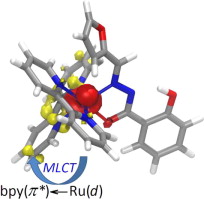
Four heteroleptic Ru(II) complexes [Ru(bpy)2(L)]X (L = bidentate N, O− donor hydrazone ligands, X = ClO4 or PF6) have been synthesized and characterized. Single crystal X-ray structures of two of the complexes are also reported. The complexes show strong absorptions in the 400–600 nm region of the visible radiation, with very similar room temperature emission spectra to that of reference [Ru(bpy)3]X2 but with the lowest energy MLCT (metal to ligand charge transfer) band bathochromically shifted by about 50 nm. Results obtained from both electrochemical experiments and DFT calculations show remarkable differences in the HOMO–LUMO properties of the hydrazone complexes compared to [Ru(bpy)3]X2. TDDFT calculations have been used to understand the nature of the electronic transitions.
Ghosh, Bipinbihari; Naskar, Sumita; Naskar, Subhendu; Espinosa, Arturo; Hau, Sam; Mak, Thomas; Sekiya, Ryo; Kuroda, Reiko, Chattopadhyay, Shyamal, Polyhedron, 2014, 72 , 115-121